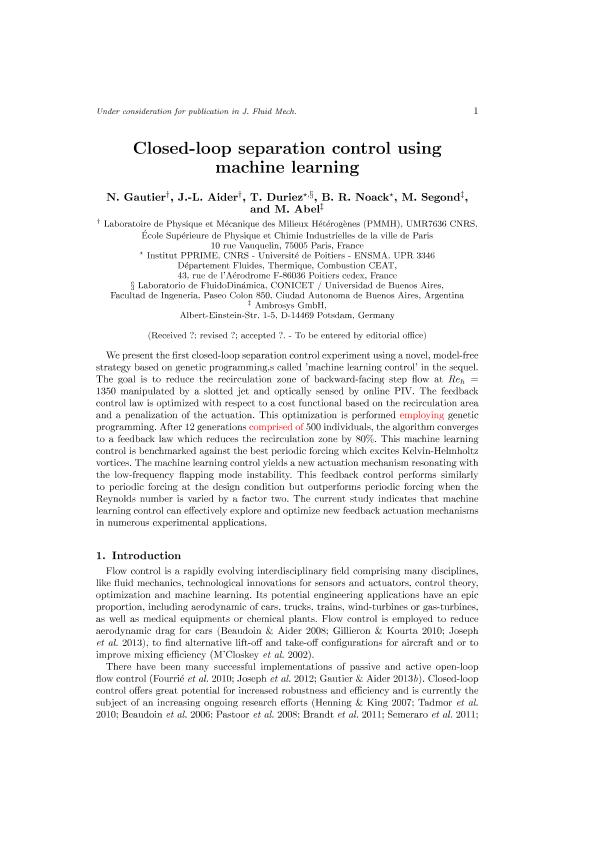Mostrar el registro sencillo del ítem
dc.contributor.author
Gautier, N.
dc.contributor.author
Aider, J. L.
dc.contributor.author
Duriez, Thomas Pierre Cornil

dc.contributor.author
Noack, B. R.
dc.contributor.author
Segond, M.
dc.contributor.author
Abel, M.
dc.date.available
2018-03-09T17:43:37Z
dc.date.issued
2015-05
dc.identifier.citation
Gautier, N.; Aider, J. L.; Duriez, Thomas Pierre Cornil; Noack, B. R.; Segond, M.; et al.; Closed-loop separation control using machine learning; Cambridge University Press; Journal of Fluid Mechanics; 770; 5-2015; 442-457
dc.identifier.issn
0022-1120
dc.identifier.uri
http://hdl.handle.net/11336/38415
dc.description.abstract
We present the first closed-loop separation control experiment using a novel, model-free strategy based on genetic programming, which we call 'machine learning control'. The goal is to reduce the recirculation zone of backward-facing step flow at Reh = 1350 manipulated by a slotted jet and optically sensed by online particle image velocimetry. The feedback control law is optimized with respect to a cost functional based on the recirculation area and a penalization of the actuation. This optimization is performed employing genetic programming. After 12 generations comprised of 500 individuals, the algorithm converges to a feedback law which reduces the recirculation zone by 80 %. This machine learning control is benchmarked against the best periodic forcing which excites Kelvin-Helmholtz vortices. The machine learning control yields a new actuation mechanism resonating with the low-frequency flapping mode instability. This feedback control performs similarly to periodic forcing at the design condition but outperforms periodic forcing when the Reynolds number is varied by a factor two. The current study indicates that machine learning control can effectively explore and optimize new feedback actuation mechanisms in numerous experimental applications.
dc.format
application/pdf
dc.language.iso
eng
dc.publisher
Cambridge University Press

dc.rights
info:eu-repo/semantics/openAccess
dc.rights.uri
https://creativecommons.org/licenses/by-nc-sa/2.5/ar/
dc.subject
Control Theory
dc.subject
Flow Control
dc.subject
Separated Flows
dc.subject.classification
Astronomía

dc.subject.classification
Ciencias Físicas

dc.subject.classification
CIENCIAS NATURALES Y EXACTAS

dc.title
Closed-loop separation control using machine learning
dc.type
info:eu-repo/semantics/article
dc.type
info:ar-repo/semantics/artículo
dc.type
info:eu-repo/semantics/publishedVersion
dc.date.updated
2018-03-09T14:46:21Z
dc.journal.volume
770
dc.journal.pagination
442-457
dc.journal.pais
Reino Unido

dc.journal.ciudad
Cambridge
dc.description.fil
Fil: Gautier, N.. École Supérieure de Physique et Chimie Industrielles de la ville de Paris; Francia
dc.description.fil
Fil: Aider, J. L.. École Supérieure de Physique et Chimie Industrielles de la ville de Paris; Francia
dc.description.fil
Fil: Duriez, Thomas Pierre Cornil. Université de Poitiers; Francia. Universidad de Buenos Aires. Facultad de Ingeniería. Departamento de Ingeniería Mecánica. Laboratorio de Fluidodinámica; Argentina. Consejo Nacional de Investigaciones Científicas y Técnicas; Argentina
dc.description.fil
Fil: Noack, B. R.. Université de Poitiers; Francia
dc.description.fil
Fil: Segond, M.. Ambrosys; Alemania
dc.description.fil
Fil: Abel, M.. Ambrosys; Alemania
dc.journal.title
Journal of Fluid Mechanics

dc.relation.alternativeid
info:eu-repo/semantics/altIdentifier/doi/http://dx.doi.org/10.1017/jfm.2015.95
dc.relation.alternativeid
info:eu-repo/semantics/altIdentifier/url/https://www.cambridge.org/core/journals/journal-of-fluid-mechanics/article/closedloop-separation-control-using-machine-learning/D28454120D1B533531BE9DADC9DF2548
Archivos asociados
